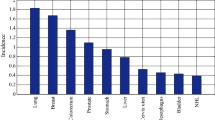Abstract
In contrast with sick people who need urgent medical attention, the clientele of preventive healthcare have a choice in whether to participate in the programs offered in their region. In order to maximize the total participation to a preventive care program, it is important to incorporate how potential clients choose the facilities to patronize. We study the impact of client choice behavior on the configuration of a preventive care facility network and the resulting level of participation. To this end, we present two alternative models: in the “probabilistic-choice model” a client may patronize each facility with a certain probability, which increases with the attractiveness of the available facilities. In contrast, the “optimal-choice model” stipulates that each client will go to the most attractive facility. In this paper, we assume that the proximity to a facility is the only attractiveness attribute considered by clients. To ensure the quality of care, we impose a bound on the mean waiting time as well as a minimum workload requirement at each open facility. Subject to a total capacity limit, the number of open facilities as well as the location and the capacity (number of servers) of each open facility is the main determinant of the configuration of a facility network. Both models are formulated as a mixed-integer program. To solve the problems efficiently, we propose a probabilistic search algorithm and a genetic algorithm. Finally, we use the models to analyze the network of mammography centers in Montreal.
Similar content being viewed by others
References
Aboolian R, Berman O, Krass D (2007a) Competitive facility location model with concave demand. Eur J Oper Res 181: 598–619
Aboolian R, Berman O, Krass D (2007b) Competitive facility location and design problem. Eur J Oper Res 182: 40–62
Achabal DD, Gorr WL, Mahajan V (1982) MULTILOC: a multiple store location decision model. J Retailing 58(2): 5–25
Berman O, Krass D (1998) Flow intercepting spatial interaction model: a new approach to optimal location of competitive facilities. Location Sci 6: 41–65
Berman O, Krass D (2002) Locating multiple competitive facilities: spatial interaction models with variable expenditures. Ann Oper Res 111(1): 197–225
Berman O, Drezner Z (2006) Location of congested capacitated facilities with distance sensitive demand. IIE Trans 38: 213–231
Drezner T (1994) Optimal continuous location of a retail facility, facility attractiveness, and market share: an interactive model. J Retailing 70: 49–64
Drezner T (1998) Location of multiple retail facilities with a limited budget. J Retailing Consumer Services 5: 173–184
Drezner T, Drezner Z (2010) Modeling lost demand in competitive facility location. Working paper, California State University-Fullerton
Earle J, Sabirianova K (2002) How late to pay? Understanding wage arrears in Russia. J Labor Econ 20: 661–707
Facione NC (1999) Breast cancer screening in relation to access to health services. Oncol Nursing Forum 26: 689–696
Feachem GA, Sekhri NK, White KL (2002) Getting more for their dollar: a comparison of the NHS with California’s Kaiser Permanente. Br Med J 324: 135–143
Gupta S, Chintagunta PK, Kaul A, Wittink DR (1996) Do household scanner data provide representative inferences from brand choices: a comparison with store data. J Market Res 33: 383–398
Holland JH (1975) Adaptation in natural and artificial systems. University of Michigan Press, Ann Arbor
Huff DL (1962) Determination of intra-urban retail trade areas. Real Estate Research Program, UCLA
Kleinrock L (1975) Queueing system I: theory. Wiley, New York
Marianov V, Serra D (1998) Probabilistic maximal covering location-allocation for congested system. J Region Sci 38: 401–424
Marianov V, Serra D (2002) Location-allocation of multiple-server service centers with constrained queues or waiting times. Ann Oper Res 111: 35–50
Marianov V, Rios M, Icaza MJ (2008) Facility location for market capture when users rank facilities by shorter travel and waiting times. Eur J Oper Res 191: 32–44
McFadden D (1974) Conditional logit analysis of quantitative choice behavior. In: Zarembkar P (ed) Frontiers in economics. Academic Press, New York
McGurik MA, Forell FW (1984) Spatial patterns of hospital utilization: the impact of distance and time. Inquiry 21(1): 84–95
McNoe B, Richardson AK, Elwood JM (1996) Factors affecting participation in mammography screening. N Z Med J 109: 359–362
Meyer RJ, Eagle T (1982) Context-induced parameter instability in a disaggregate-stochastic model of store choice. J Market Res 19: 62–71
Nakanishi M, Cooper LG (1974) Parameter estimation for a multiplicative competitive interaction model: least squares approach. J Market Res 11(3): 303–311
National Cancer Institute (2011) http://www.cancer.gov/cancertopics/factsheet/Detection
Okunuki K, Okabe A (2002) Solving the huff-based competitive location model on a network with link-based demand. Ann Oper Res 111(1): 239–252
Prime Minister of Canada (2007) http://www.pm.gc.ca/eng/media.asp?id=1611
Reeves CR (1995) Modern heuristic techniques for combinatorial problems. McGraw Hill, New York
Svitone EC, Garfield R, Vasconcelos MI, Craveiro VA (2000) Primary health care lessons for the Northeast of Brazil: the Agentes de Saude Program. Pan Am J Public Health 7: 293–301
Verter V, Lapierre SD (2002) Location of preventive health care facilities. Ann Oper Res 110: 123–132
Wang Q, Batta R, Rump CM (2002) Algorithms for a facility location problem with stochastic customer demand and immobile servers. Ann Oper Res 111: 17–34
World Health Organization (2002) Fact sheet No 172. http://www.who.int/mediacentre/factsheets/fs172/en/index.html
Zhang Y, Berman O, Verter V (2009) Incorporating congestion in preventive healthcare facility network design. Eur J Oper Res 198: 922–935
Zhang Y, Berman O, Marcotte P, Verter V (2010) A bilevel model for preventive healthcare facility network design with congestion. IIE Trans 42: 865–880
Zimmerman S (1997) Factors influencing hispanic participation in prostate cancer screening. Oncol Nursing Forum 24: 499–504
Author information
Authors and Affiliations
Corresponding author
Rights and permissions
About this article
Cite this article
Zhang, Y., Berman, O. & Verter, V. The impact of client choice on preventive healthcare facility network design. OR Spectrum 34, 349–370 (2012). https://doi.org/10.1007/s00291-011-0280-1
Published:
Issue Date:
DOI: https://doi.org/10.1007/s00291-011-0280-1




